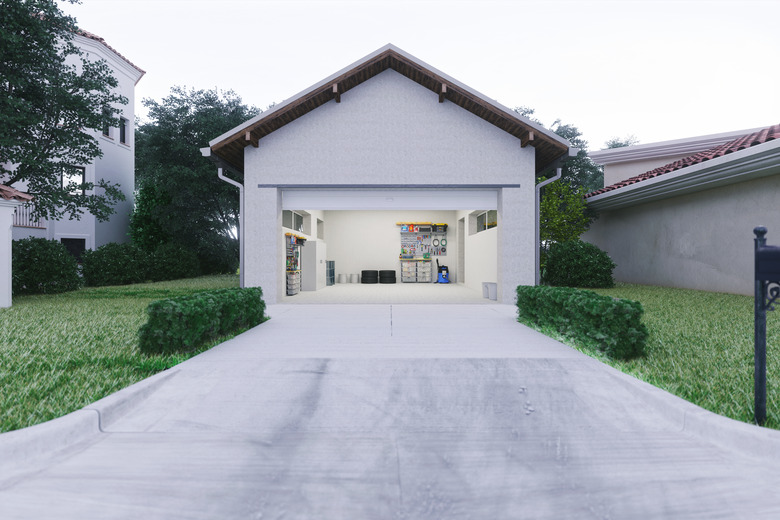How To Avoid Tire Marks On Concrete Driveways
We may receive a commission on purchases made from links.
The presence of black tire marks on a concrete driveway is an annoying recurrence. Whether they are caused by hot concrete, street resurfacing, squealing tires, or an unknown source, preventing the unsightly marks requires a multipronged approach. This often requires a thorough cleaning and then application of a sealant or other protective element to help keep the concrete pristine.
Avoid Tire Marks on a Concrete Driveway
Avoid Tire Marks on a Concrete Driveway
Tire marks on a concrete driveway may have several sources. If the city is resurfacing and/or sealing local streets, you may have driven across the liquid asphalt mixture before it was completely cured. Avoid driving on newly resurfaced streets if possible. Even if your tires picked up some of the sealer and transferred it to your driveway, the stains should fade and disappear within 30 days.
Another source of tire marks may be the hot tires resting on previously sealed concrete. High-quality tires contain more plasticizers, which are polymer compounds used in the rubber to improve traction. While driving, the tires get hot, and when parked, the plasticizers leach out of the tire and into the acrylic sealer on the concrete. While buying cheaper tires that contain less plasticizer is probably not an acceptable option, resealing the concrete with a higher-solids acrylic, polyurethane, or epoxy sealer reduces and/or eliminates the tire marks.
Another source of black tire marks involves impatience or showing off. Whether riding a bicycle or motorcycle or driving a car, skid marks caused by slamming on the brakes or "burning out" mar the driveway. Removing the marks as soon as possible, preferably with a scrub brush, may discourage a repeat performance by the offending individual.
Remove the Tire Marks
Remove the Tire Marks
Removing black tire marks on a concrete driveway or pavers is best accomplished quickly. The longer the marks are on the driveway, the more scrubbing it will require to remove them. First, sweep the driveway to remove dirt and debris. Soak the tire marks with water for five to 10 minutes and then scrub with a deck brush or broom. This may be enough to remove light stains.
If water isn't enough, cover any delicate plants near the concrete or pavers to protect their roots, foliage, and flowers from the cleaning solution. Mix 1/4 cup dishwashing liquid with 1 to 2 gallons warm water and apply it to the stains. Let it soak in for at least five minutes and then scrub with a stiff-bristled brush or deck broom. Rinse thoroughly with water.
The next level of cleaning requires a concrete cleaner or degreaser. Mix according to the package directions and apply it to the tire marks. Allow it to soak in for 15 minutes and then scrub and rinse. If you choose to use a pressure washer, apply the soap solution to the pavers or concrete with the low-pressure soaping nozzle, let it soak for five minutes, and then clean with a surface cleaner attachment and rinse with a 25-degree nozzle.
Resurface the Driveway
Resurface the Driveway
A concrete driveway that features stubborn asphalt stains or reminders of squealing tires plus additional wear and tear due to age and weathering may need more than just a good cleaning. Consider resurfacing the concrete, which also allows you to add color and texture to the driveway. Power wash the driveway using a high-strength nozzle and then patch any damaged areas with a compatible patching product. Add 1/4-inch weather stripping over existing control and expansion joints.
Mix the concrete resurfacing product with a drill and paddle mixer in a 5-gallon bucket according to the package directions. Apply it to the concrete in 1-foot-wide strips and scrub it into the concrete with a long-handled squeegee, spreading it evenly over the driveway. Wait five minutes and then stamp or brush with a concrete broom. Mist as needed for 24 to 48 hours as the new concrete surface cures.
Seal the Concrete Driveway
Seal the Concrete Driveway
After the driveway has completely dried and/or cured, apply three thin coats of sealer with a roller or sprayer. Let the sealer dry between coats for the recommended time per the manufacturer's instructions. Sealers are available in a variety of matte, low-gloss, or high-gloss formulations. A matte or low-gloss surface is less obvious and slippery than a high-gloss sealer. Clean the driveway and reapply the sealer every three years.
